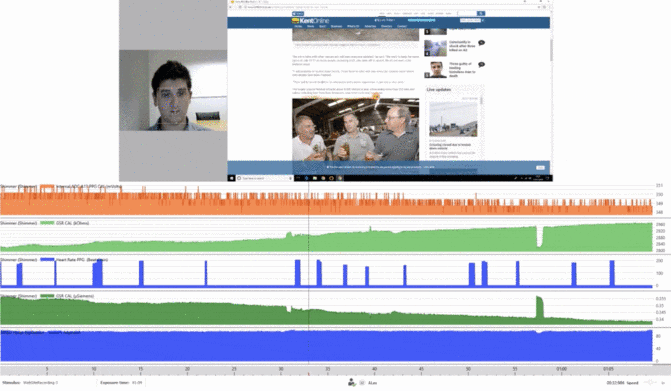The Future of Conversion Rate Optimisation Demands Biometrics
Conversion Rate Optimisation (CRO) as we know it is limited. A part of the user testing process is to ask people what they think of your site and observe how they use it.
What is biometrics?
Where conventional user testing asks people to give verbal, conscious feedback while they use your store, biometrics measures the unspoken, physical response that's happening in the background. As with any scientific study, tests take place in a lab using specialist equipment. You'd be forgiven for not knowing a great deal about it since only a handful of biometrics labs exist in the world.
Inside the lab, people browsing your site have sensors attached to them; they track things like heart rate and monitor activity in different areas of the body. These calculations are then recorded on a computer system and examined by data analysts as well as trained psychologists. Like Yin and Yang, the statistical facts and psychological interpretation complement one another to form a complete picture.
Where do biometrics and CRO meet?
CRO involves conducting experiments. You might test two pages to see if page A converts better than page B, or use heat maps to see which area of a page gets the most clicks. What CRO experts can get frustrated by is the missing finer detail. Biometrics can highlight information that simply isn't possible to determine using other methods. Here are just three of the techniques used to uncover more data:

1. Facial expression analysis
Biometrics testing will challenge even the best poker face. It's used to monitor 34 points on the face, such as the corners of the mouth and the tip of the chin. Movement in these areas gives away our true feelings. Through machine learning 20 facial expressions can be determined, plus seven key emotions are detected, including surprise, contempt, and joy. You'll soon know if your content is dire or delightful.
2. Galvanic Skin Response (GSR)
The amount of sweat people secrete gives away the secret to how people feel about a situation, knowingly or unknowingly. We're not talking about a jog in the park type of sweat, but subtle cues in the moisture level on the palm of the hand that can be measured using biometrics. Sweat can signal stress or arousal. Combine GSR with facial expression analysis, for example, and it's clear which it is.
3. Eye tracking and Areas of Interest (AOI)
Using biometrics, you can see how long it takes for a user to find the information you want them to see, then how long they spend looking at it. If it takes people a long time to find your call to action, that's quickly evident. Or if they linger over a message that—clearly—isn't clear. Armed with this information, you can move things around the page or change content so any barrier to conversion is taken away.
How can biometrics improve CRO?
Let's consider that someone reaches your call to action quickly but spends a long time looking at it. Maybe they don't want to admit to being confused in case they look silly, but GSR tests reveal they're feeling stressed and facial expression analysis detects fear. Biometrics reveals what's not being said, so you can edit out any points of confusion and guide users through your store without delay.
There is all manner of fascinating nuances that exist in our brain, which biometrics can help to capture:
- Did you know the faster you take something in, the better the feeling you have about the source of the information? It's called Processing Fluency. Remove sticking points on your site so shoppers can glide through it quickly and those positive vibes are all projected onto your brand.
- Researchers found the brain is seven seconds ahead of the actions we take. That means when someone adds to their cart, their brain decided to buy your product before you see this unfold with a click of the mouse. Biometrics can highlight the journey that precedes the click.
"By looking at brain activity while making a decision, the researchers could predict what choice people would make before they themselves were even aware of having made a decision." – Nature.com, 2008
Verbal mutterings and visual clues can only get you so far in your quest for more sales. Add biometrics user testing to the process and you add depth to your hypothesis. Rather than waste time on an incorrect assumption, you can work with greater accuracy to increase your conversions.
Is biometrics likely to replace traditional methods?
All user testing is about getting to know your customer better. For a site to be successful, you have to know their every foible. It's the reason why brands create customer personas and use personalization, so you can focus on what your customer likes the most and give them more of the things they want.
Biometrics testing lets you peek inside the minds of those consumers. Without this, results from conversion optimization experiments can feel incomplete. Biometrics is not a replacement for other user testing methods but does provide more meaningful insight into your buyer's behavior.
Current success stories
When HR GO Recruitment worked with British biometrics lab, Space Between, they saw a 153% increase in conversions. Advertising jobs online, HR GO used a sense of urgency in their copy. Yet instead of encouraging candidates to act quickly, biometrics tests revealed that people were stressed out by them. It had the opposite effect. Sweat production increased, as did heart rates. Facial postures and emotions were negative. A change in tactic increased revenue for the company by £2 million.